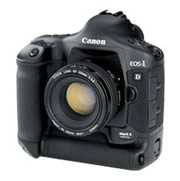Canon EOS-1D Mark II Digital SLR Camera
Canon Updated: 2007-07-23The reborn EOS-1D achieves 8.2 effective megapixel resolution even at a continuous shooting speed of 8.5 frames-per-second. This extraordinary feat is more than evolution, it’s a revolution in digital camera performance. Versatility, operational ease and all aspects of camera design have been meticulously refined to give professionals a genuine edge at decisive moments.
Features
- Image Recording
- Shooting Performance
- Image Display
- System
- Digital Photo Professional
CMOS Sensor
Canon's newly developed single-plate CMOS sensor with 8-channel reading technology delivers exceptional image quality and accelerated continuous shooting. Large and extremely sensitive, with approximately 8.2 million effective pixels (8.5 million total pixels) and a generous 28.7 x 19.1mm image size, it faithfully captures every nuance of your scene from highlights to shadows. Moreover, extensive noise reduction ensures an extremely high S/N ratio. Framing is natural because the sensor's 3:2 aspect ratio is the same as in 35mm cameras, and the sensor's large size realizes an effective angle of view that's just 1.3 times the focal length indicated on Canon EF lenses.
DIGIC II Image Engine
Compatible with DDR SDRAM, Canon's newly developed, state-of-the-art DIGIC II image engine achieves super high speed processing that results in continuous shooting of 8.2 megapixel images at 8.5 fps in maximum bursts of 40 (JPEG format) or 20 (RAW format) shots. This single-chip image processor employs original Canon algorithms to accurately convert signals from the CMOS sensor into crisp, high-quality images with natural color and rich gradation. By handling larger volumes of image data, DIGIC II also contributes to lower power consumption: up to about 1,200 shots can be taken on a full battery at 20ºC, or around 800 shots at 0ºC.
Memory Card Slots
Professionals and serious amateurs alike will appreciate the new flexibility that two memory card slots provide. Images can be recorded on a CompactFlash card or SD memory card alone; on both cards at the same time as a safeguard against losing important data; or on both cards, one at a time, to maximize storage capacity. Type I and Type II CompactFlash cards with capacities up to and beyond 2GB are supported. Other advances include faster writing of image data to memory cards and an easier-to-open slot cover knob.
Recording Quality
Images can be recorded in the JPEG image format, the RAW image format, or both formats simultaneously – with unprecedented control over image quality. The JPEG format is ideal when reduced file sizes are desired, and provides four quality settings (L, M1, M2, S) at any of ten compression ratios, as opposed to the Fine and Normal ratios available in previous models. Settings are easily selected by using a dedicated button that changes the setting shown on the rear LCD panel with each press. Canon's proprietary RAW format offers higher image quality, with rich 12-bit gradation and lossless image compression, but requires processing before use on a computer. This new CR2 version of the RAW format will be used on all future Canon digital cameras.
Color Matrix
Seven Color Matrix settings are provided for JPEG and RAW images, allowing unparalleled control over color characteristics. The settings include five factory presets that were previously available and two new settings that allow independent user adjustment of color space, color saturation and color tone within a prescribed range. Users can choose the more versatile sRGB color space or the Adobe RGB color space, which is ideal for fine-tuning the color saturation of images on a PC or outputting images for commercial printing in an Adobe RGB environment. Five-level adjustment is provided for both color saturation (Low, Slightly Low, Standard, Slightly High and High) and color tone (-2, -1, Standard, +1 and +2).
ISO Speed
ISO speeds are selectable in 1/3 increments (100-1600) and may be set as low as 50 or as high as 3200 through the ISO extension menu. This is the widest ISO speed range of any EOS digital camera. When combined with a high shutter speed, a high ISO speed can produce blur-free photos in dark settings.
White Balance
Through 10 selectable white balance modes and other advanced WB settings, the user can obtain highly accurate color reproduction in almost any kind of lighting. New WB Compensation allows adjustment of blue/amber and magenta/green biases in ±9 steps, as well as combined use of light-balancing (LB) and color-correction (CC) equivalent digital color filters. In fact, 360 combinations of 36 (4 colors with 9 steps each) built-in digital color filters are possible. Improved WB Bracketing creates three bracketed images from a single shutter release by shifting the white balance by up to ±3 levels from the value set in the current WB mode. Images can also be bracketed to a magenta/green or blue/amber bias.
EOS-1D Mark II INSTRUCTION MANUAL
EOS DIGITAL Solution Disk Software Instruction Manual
Digital Photo Professional for Windows INSTRUCTION MANUAL
Digital Photo Professional for Macintosh INSTRUCTION MANUAL
Related Manuals
Canon EOS 20D Digital SLR Camera
Canon EOS-1D Digital SLR Camera
Canon EOS-1Ds Digital SLR Camera
Canon EOS Digital Rebel Digital SLR Camera
Canon EOS 10D Digital SLR Camera
Canon EOS D60 Digital SLR Camera
Canon EOS D30 Digital SLR Camera
Canon EOS ELAN 7/7E 35mm SLR Camera
Canon EOS Rebel 2000 35mm SLR Camera
Canon EOS Rebel G 35mm SLR Camera
Canon EOS Rebel GII 35mm SLR Camera
Canon EOS Rebel Ti 35mm SLR Camera
